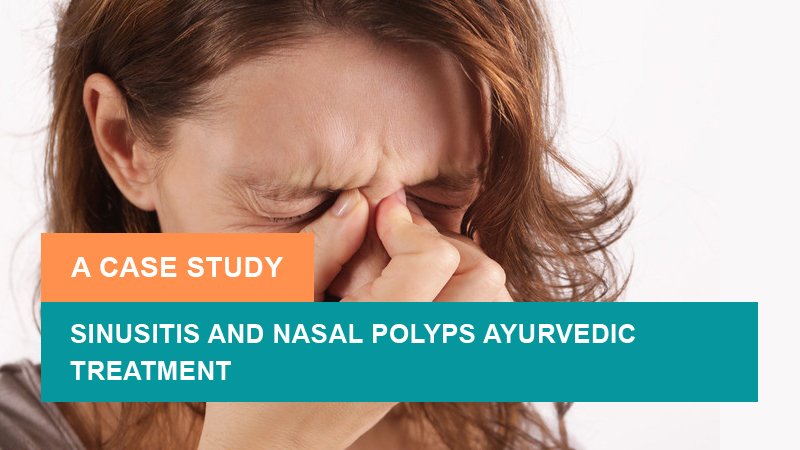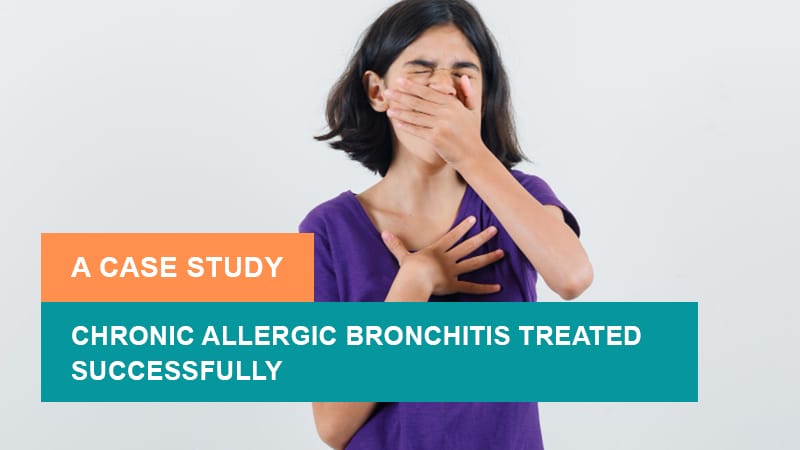The treatment of sinusitis and nasal polyps remains limited and recurrence rate is very high. The patients have to use steroid spray indefinitely to avoid recurrence. Despite these measures a number of patients have multiple nasal polyp recurrences which necessitate further surgery but sinusitis and nasal polyps can be treated with a high success rate by various Ayurveda treatment measures. Dr. Sahil Gupta, well – known Ayurveda Allergy Specialist has successfully treated thousands of patients suffering from sinusitis and nasal polyps. IAFA’s successful Ayurvedic measures under the guidance of Dr. Sahil Gupta assure complete cure. This blog presents a case study of sinusitis and nasal polyps successfully treated through Ayurvedic treatment by Dr. Sahil Gupta.
Abstract
Nasal polyp is a chronic inflammatory disorder affecting 1-4% of the general population. These are characterized by fleshy benign growth that develop in the mucosal lining of the nasal passage and paranasal sinuses. It is known to have associations with asthma, infection, allergy, cystic fibrosis etc. The medical management of nasal polyp and sinusitis is aimed at relieving the symptoms until surgery can be arranged but due to the nature of nasal polyposis as an inflammatory disease of the mucous membrane, surgery cannot be expected to cure the disease. In Ayurveda, this condition is closely related to Nasa Arsha which is a Kapha-Vata Vyadhi located in Urdwanga which is the site of Kapha dosha. This blog presents a case study of a 39 years old female patient who approached IAFA having symptoms – sinus pain in the right maxillary with headache, nasal polyp, recurrent ear pain with itching in right ear. She took modern, homeopathic and ayurvedic treatments but there was no relief in her condition. She approached IAFA on 13th January, 2022 via online consultation. At IAFA, an approach was made to treat the patient by sthanika, shodhan and shaman chikitsa with a positive clinical response. This study aimed at introducing a new treatment modality which is a non-invasive Ayurvedic treatment of nasal polyps.
Keywords: Successful non-invasive treatment of nasal polyps, Ayurvedic treatment of Nasal Polyp, Ayurvedic treatment, Nasya
According to Ayurvedic perspective, Master Sushruta, while dealing with the diseases of the nose, devoted a separate chapter to Pratishyaya after explaining Nasagata Roga in detail. In general, the features of the disease are similar to that of chronic sinusitis in modern science.
Ayurvedic Concept
“Srotasam Atipravruti” means “body channels hyperactivity” is the reason for Allergy as per 5000 years ago ancient Ayurveda principles. Any sort of over activity happening at these 13 internals and 7 externals body channels leads to the manifestation of allergies by exhibiting symptoms on various body tissues.
Ayurvedic Reference
कासारुचिम्रावघनप्रसेकाः कफाद् गुरुः स्रोतसि चापि कण्डूः॥
Symptoms of Sinusitis that is known as “Kaphaja Pratisyaya” is well brief in Sanskrit language. The above shloka stated that in Kaphaj Prathyaya- cough, anorexia, thickened phlegm, and itchy nose are the major symptoms.
दोपैस्त्रिभिस्तैःपृथगेकशश्च l
ब्रूयात्तथाऽसितथैवशोफान् ll
In Ayurveda four types of Nasarsha (nasal polyps) – Vataja , Pittaja, Kaphaja and Sannipataja are described by Aacharya Sushruta among thirty one Nasagata rogas (one which affects nose ) and Aacharya Charaka has also mentioned in Arsha (hemorrhoids) chikitsa about the fleshy growth appear on the nose similar to nasal polyp. As per Ayurveda, symptoms include:
- Nasal block (Nasa-avarodha)
- Breathing difficulty (Krucha swasa)
- Running nose (Nasa strava)
- Snoring
With the objective of understanding the better pathogenesis, the author presents a case report.
Case Report
- Name: Pratibha
- Address: Mumbai, India
- Age/Gender: 39/F
- UID: 6828
- Date of online consultation: 13/01/2022
Patient’s Symptoms
- Sinus pain in right maxillary with headache
- Recurrent attack of nasal blockage especially in the right nostril
- Purulent mucoid discharge of yellowish color
- Nasal polyp
- Recurrent history of ear pain with itching in the right ear
Treatment Plan
External Procedure:
For Nasal: Pratimarsha Nasya Karma with:
- IAFA Nasal All Clear X Drops
- IAFA Nasal All Clear Spray
Internal Medication:
IAFA Swaras Chikitsa:
- Total Care 3X
- IAFA Respiratory Detox Tablets
- Sitopaladi Churna Tablet
- IAFA Res – Chai 7
Dosage/How to use:
- IAFA Nasal All Clear X Drops: 4-6 drops to be instilled in bilateral nostrils twice a day in early morning and late evening.
- IAFA Nasal All Clear Spray: Spray directly into one nostril by closing the other nostril twice or thrice a day.
- Total Care 3X: 60 ml with water once in a day early morning empty stomach with water.
- IAFA Respiratory Detox Tablets: 750 mg 2 tablets twice a day to be taken 15 minutes before meals with lukewarm water.
- Sitopladhi Tablet: 2 tablets twice a day 15 minutes before meals with lukewarm water.
- IAFA Res Chai – 7: ½ teaspoon (2.5 g approx.) for 1 cup of tea to be taken twice a day.
Product Description
1) IAFA Nasal All Clear X Drops
IAFA Nasal All Clear X Drops was prescribed to the patient for Nasya Karma. Nasya Karma helps in strengthening the vital functions of sense organs by its unique mode of action through Shringataka Marma. Sthanika (local application) chikitsa helps in opening the Vatavaha srotas and lightens the head. The ingredients of IAFA Nasal All Clear X Drops are: Jyotishmati (Celastrus paniculatus), Maricha (Piper nigrum), Pippali (Piper longum), Vidanga (Embelia ribes), Shigru (Moringa pterygosperma), Haridra (Curcuma longa), Nagarmotha (Cyperus scariosus), Bruhati (Solanum indicum), Sariva (Hemidesmus indicus), Yashtimadhu (Glycyrrhiza glabra) and Til Thailam (Sesamum indicum).
- Jyotishmati (Celastrus paniculatus): Jyotishmati, also known as Malkangani is among the group of herbs useful in Nasya treatment. It balances Vata and Kapha doshas.
- Maricha (Piper nigrum): Maricha, commonly known as Kaali mirch is certainly not just a spice but it removes toxins and helps in healing. It is theekshana (strong and piercing) in nature and sookshma (enters deep into minute body channels).
- Pippali (Piper longum): Pippali is described among the group of herbs that is good for throat disorders and useful in expelling doshas from head and neck. Pippali is also described as an herb useful in expelling imbalanced doshas nasal route through Nasya treatment.
- Vidanga (Embelia ribes): Vidanga is known as False black pepper because it mimics pepper in appearance. Due to its qualities such as – laghu (lightness), ruksha (dryness), teekshna (piercing and strong) and ushna (hot potency), it is widely used in respiratory tract disorders.
- Shigru (Moringa pterygosperma): Shigru, commonly known as Drumstick, has been a part of the Indian diet since ages. It is characterized under a group of herbs that are useful in Nasya Panchakarma treatment and also used in Sevedana Chikitsa.
- Haridra (Curcuma longa): Turmeric is a very common and very useful Ayurvedic herb. It is used in many forms and through many routes of administration, such as nasal, oral etc. Due to its tikta-katu rasa (bitter and pungent tastes), ushna veerya (hot potency), katu vipaka (undergoes pungent taste conversion after digestion), ruksha guna (dry quality), it removes block from blood vessels making the circulation of blood and nutrients easy.
- Nagarmotha (Cyperus scariosus): Commonly known as nut grass, it shows actions against microbes as well as other external factors, therefore useful in allergic disorders.
- Bruhati (Solanum indicum): Bruhati, commonly known as Bahupatrika alleviates diseases like asthma, cough, cold etc. It is one among Dashamoola (group of 10 herbs) having potent anti-inflammatory properties.
- Sariva (Hemidesmus indicus): Sariva is known as Indian Sarsaparilla. The smell of its roots resembles the smell of camphor. It is a triodoshahara herb.
- Yashtimadhu (Glycyrrhiza glabra): Yashtimadhu, commonly known as Mulethi, pacifies aggravated Vata, Pitta and Kapha doshas. It improves voice, provides good strength and immunity and is an excellent remedy for throat disorders.
2) IAFA Nasal All Clear Spray:
The composition of IAFA Nasal All Clear Spray is as follows: Tulsi (Ocimum sanctum), Dronapushpi (Leucas aspera), Chandramallika (Kaempferia galanga), Agnimandha (Premna integrifolia), Vacha (Acorus calamus), Ajaji (Cuminum cyminum), Madhuka (Madhuca longifolia) and Saindhavam (Sodii chloridum).
- Tulsi (Ocimum sanctum): Tulsi is an auspicious herb that balances Vata and Kapha doshas. It is an anti-microbial and one of the best antiviral herbs of Ayurveda. The juice of tulsi leaves is beneficial in sinusitis and headache.
- Dronapushpi (Leucas aspera): Dronapushpi has the property of Kshara (able to scrape the sputum out due to its property of scraping). It is also useful in fever due to vitiation of Kapha and Vata doshas.
- Chandramulika (Kaempferia galanga): Chandramulika, known as aromatic ginger. Traditionally, the rhizomes have been used to treat several disorders such as inflammation, infections, respiratory tract disorders etc.
- Agnimandha (Premna integrifolia): Agnimandha is classified under anti-inflammatory herbs and under group of herbs to relieve cold in Ayurveda. This herb is hot in potency and balances Vata and Kapha doshas.
- Vacha (Acorus calamus): Vacha is known as Sweet Flag in English. It is characterized under group of herbs that are useful in Nasya treatment. This herb improves speech, voice, and is ant-microbial in nature. It also improves Medhya (intelligence).
- Ajaji (Cuminum cyminum): Ajaji is commonly known as cumin seeds. It is classified under the Pippalyadi group of herbs in Ayurveda. It is fragrant, improves intellect, alleviates kapha dosha, improves strength and immunity etc.
- Madhuka (Madhuca longifolia): Madhuka commonly known as Butter tree is used for nasal administration in Ayurveda. Its use is indicated in Shwasa (asthma and chronic respiratory disorders), Kasa (cough and cold), kshaya (depletion of body tissues, weight loss etc.)
- Saindhavam (Sodii chloridum): Saindhavam salt is considered best among all salts. Because of its taste, it is useful in relieving chest congestion due to sputum accumulation.
3) Total Care 3X Ras:
The key ingredients of Total Care 3X are: Satyanashi (Argemone mexicana), Dronapushpi (Leucas cephalotes), Sirisha (Albizia lebbeck), Bhoomi Amla (Phyllanthus niruri), Vasa Putapaka (Adhatoda vasica), Dugdhdika (Euphorbia hirta), Yavakshara (Hordeum vulgare) and Yashtimadhu (Glycyrrhiza glabra).
- Satyanashi (Argemone mexicana): Satyanashi known as Mexican poppy is characterized under Guduchyadi Varga in Dhanvantri Nighantu. Being a natural purgative, it is useful in mobilized imbalanced doshas from the different body parts to the intestines.
- Dronapushpi (Leucas cephalotes): Dronapushpi is widely used in treating asthma, cough, cold, liver disorders, jaundice etc. It is useful in disorders of vitiated Kapha dosha, weak digestive fire and wholesome for the body.
- Sirisha (Albizia lebbeck): According to Charak Samhita, Sirisha is categorized under analgesic group of herbs. It also relieves inflammation, cold, cough and brings about quick wound healing.
- Bhoomi Amla (Phyllanthus niruri): The whole plant of Bhoomi Amla possesses medicinal properties. Bhoomi Amla is also used as an ingredient in Chyawanprash. It reduces vitiated Kapha and Pitta doshas.
- Vasa Putapaka (Adhatoda vasica): It is also known as Malabar Nut. It is a powerful herb useful in bronchitis, excessive mucous, bronchitis, chronic respiratory tract infections etc.
- Dugdhdika (Euphorbia hirta): Due to its powerful action on respiratory tract disorders, dughdika is also known as Asthma plant. The decoction of this plant is useful in respiratory tract disorders of chronic kapha origin.
- Yavakshara (Hordeum vulgare): Yavakshara is an alkali preparation from the plant barley. It is useful in kasa (cough). Alkali preparations in general are sharp, hot, light, unctuous and digestive stimulating in nature.
- Yashtimadhu (Glycyrrhiza glabra): Yashtimadhu is commonly known as Multethi. It is used conventionally in Ayurveda for the treatment of respiratory and digestive tract disorders. It is considered as “Rasayana”. It is widely used in the treatment of chronic bronchial conditions.
4) IAFA Respiratory Detox Tablet:
IAFA Respiratory Detox Tablet is one of the most effectively used herbal preparations giving relief to millions suffering from chronic respiratory tract disorders. It contains herbs which have excellent anti-allergic action. The key ingredients of IAFA Respiratory Detox Tablets are: Hingu (Ferula narthex), Surasa (Ocimum sanctum), Jivanti (Leptadenia reticulata), Ela (Elettaria cardamomum), Bhumiamla (Phyllanthus niruri), Kanthkari (Solanum xanthocarpum), Bruhati (Solanum indicum), Agaru (Aquilaria agallocha), Puskarmool (Iris germanica) and Ustekudus (Lavandula stoechas).
- Hingu (Ferula narthex): Hingu, known as heeng in Hindi is anti-inflammatory, expectorant, antioxidant, hepatoprotective, digestive stimulant, antiviral in nature due to its deepaneeya (herbs that improve digestion power) and Svashara (herbs that are useful in asthma and other respiratory disorders) properties.
- Surasa (Ocimum sanctum): Surasa, known as Tulsi is rich in antioxidants and natural phytochemicals which support respiratory system, immune system, digestive system etc. It has immunomodulatory properties due to which it is useful in recurrent infections, productive cough, bronchitis and it also acts as a digestive stimulant.
- Jivanti (Leptadenia reticulata): Jivanti is considered as one of the best rejuvenator plants in Ayurveda. It is immuno-modulatory, analgesic, anti-allergic in nature.
- Ela (Elettaria cardamomum): Ela, known as Elaichi, has several health benefits. The seeds of ela are used in Ayurvedic preparations for respiratory disorders. It is also an ingredient of Sitopaladi Churna, which is a famous Ayurvedic medicine for nasal polyps, recurrent respiratory infections, cough, asthma, cold and several other diseases.
- Bhumi Amla (Phyllanthus niruri): The presence of Amla-like fruits under the leaves is the main feature of this herb. Therefore, the herb got its name. This herb is one among the multipotent Ayurvedic herbs having actions like anti-allergic, anti-fungal, anti-viral, anodyne, astringent, appetizer, lithotripter and laxative.
- Kanthkari (Solanum xanthocarpum): Kanthkari is known as Chotti Kateri in Hindi which is among the Dasmoola group of herbs (group of 10 roots). Kanthkari is widely used in Ayurveda for the treatment of cough, cold, allergies and other respiratory tract conditions. It is also useful in laryngitis, hoarseness of voice etc.
- Bruhati (Solanum indicum): Bruhati, known as Badi Kateri is among the group of Dashmool herbs, a group of 10 roots having potent anti-inflammatory activity. This herb is widely used in the treatment of respiratory disorders.
- Agaru (Aquilaria agallocha): Agaru is a fragrant tree commonly known as Agarwood. It is characterized under Shvashara (group of herbs that relieves asthma, bronchitis, allergic disorders etc.), Shiro Virechanopaga (group of herbs useful in Nasya treatment) by Acharya Charak.
- Pushkarmool (Iris germanica): Puskarmool herb is used in the treatment of a wide range of respiratory disorders in Ayurveda. It is regarded as one of the most powerful herbs for the treatment of respiratory disorders.
- Ustekudus (Lavandula stoechas): Ustekudus is a perennial, ornamental and medicinal plant. The extract of the flowers of this plant has antibacterial, antifungal, anti-allergic and anti-oxidant properties.
5) Sitopaladi Churna Tablet:
Sitopaladi Tablet is prepared from Sitopladi Churan. Sitopladi Churan is a classical Ayurvedic preparation beneficial in various disorders relating to respiratory system, immune system and digestive system. The main action is generally seen in respiratory troubles. It works in the management of cough, chronic fever, debility etc. after chronic disorders. The ingredients of Sitopaladi Tablet are: Misri (crystallized sugar lump), Vanshlochan, Pippali (Piper longum), Elaichi (Elettaria cardamomum) and Cinnamon (Zeylanicum cinnamon).
6) IAFA Res Chai-7
IAFA Res Chai – 7 tea is a proprietary Ayurvedic blend of 7 respiratory system wellness herbs. These herbs work in a synergistic manner to balance vitiated Vata and Kapha doshas. It is a pure 100% vegetarian product and free from chemicals and preservatives. Herbs used in the preparation of IAFA Res Chai – 7 are: Tulsi (Ocimum tenuiflorum), Karpooravali (Coleus aromaticus), Yashtimadhu (Glycyrrhiza glabra), Changeri (Oxalis corniculata), Chaimomail (Matricaria chamomilla), Talis patra (Abies webbiana), Joofa (Hyssopus officinalis), Choti Papal (Piper longum), Ginger (Zingiber officinale), Ela (Elettaria cardamomum), Dalchini (Cinnamomum zeylanicum) and Yavakshara (Hordeum vulgare).
- Tulsi (Ocimum tenuiflorum): The plant tulsi is known for a wide range of therapeutic properties. The major active constituent of tulsi is eugenol. It has many therapeutic properties such as: antipyretic, anti-inflammatory, antiasthmatic, hepatoprotective, expectorant etc.
- Karpooravali (Coleus aromaticus): The leaves of this plant are quite aromatic and fleshy. In South India, this plant is used in preparing certain dishes. Due to the presence of high amounts of thymol in thymol in karpooravali, it acts as an excellent expectorant.
- Yashtimadhu (Glycyrrhiza glabra): Yashtimadhu, known as Mulethi is sweet in taste and reduces inflammation. Due to its antibacterial property, it reduces the infection of upper respiratory tract, irritation in throat and also helps in chronic cough.
- Changeri (Oxalis corniculata): Changeri is commonly known as “Indian Sorrel”. Changeri is well known for its actions like carminative, anti-allergic, anti-inflammatory, anti-bacterial, digestion promoting etc.
- Chaimomail (Matricaria chamomilla): Chaimomail is a daisy-like flower. It is loaded with multiple health benefits. It is not only effective for physical health but also has a wondrous effect in keeping the mind healthy. It has an indispensable role in boosting immunity.
- Talis patra (Abies webbiana): The leaves of Talis patra plant are used in various ayurvedic preparations meant for respiratory disorders. These leaves have anti-inflammatory and bronchodilatory action on airways and lungs.
- Joofa (Hyssopus officinalis): The leaves of joopha are used in the treatment of upper respiratory tract infections, cough in children, rhinitis and headache. It is also used in the treatment of constipation, inflammation, hepatomegaly etc.
- Choti Papal (Piper longum): Choti Papal is commonly known as Long Pepper. It balances Vata and Kapha doshas, improves digestion strength, useful in COPD, asthma and other respiratory conditions.
- Ginger (Zingiber officinale): Ginger is commonly used as a spice, flavoring agent as well as herbal remedy in almost every Indian household. It is purgative, appetizer, and anti-inflammatory due to the presence of healthy phytochemicals.
- Ela (Elettaria cardamomum): The seeds of Ela (Elaichi) are used in Ayurveda for the treatment of respiratory disorders. It is also an ingredient of Sitopaladi Churna which is a classical Ayurvedic preparation for recurrent respiratory infections, asthma, cold, allergies and several other disorders.
- Dalchini (Cinnamomum zeylanicum): Cinnamon is a wonderful spice that relieves throat pain, microbe infestation related to lungs, useful in allergic rhinitis, running nose, cough and sputum, ama (product of indigestion and altered metabolism).
- Yavakshara (Hordeum vulgare): Yavakshara is an alkali preparation of plant barley useful in improving digestion strength, balancing Kapha and Vata doshas, light to digest, minute and piercing in nature.
Diet Plan
The allergic progression started due to inhalant allergens and other environmental factors in the present case. Due to weak digestive fire, the microbial activities in the stomach also get aggravated resulting in the formation of Aama Visha (difficult to digest products generated within the body) or toxin accumulation within the body so Dr. Gupta recommended the patient to take food which is alkaline in nature, stimulate digestions, maintain pH balance along with Ayurvedic treatment.
Do’s (Pathya):
- Light and easily digestible food
- More fiber containing fruits and vegetables
- Fresh curd in mid-noon only with black pepper
- Frequent intake of small amounts of lukewarm water
- Fresh fruits such as pomegranate and apples on daily basis
- Use of spices such as – garlic, turmeric, ginger, black pepper
Don’ts (Apathya):
- High lactose diet such as cream, cheese, soft cheese
- High fat foods like butter, margarine, sour food
- Spicy, deep fried and packaged food
- Yeast fermented food and fermented beverage food
- Fruits like banana and avocado
- Chilled water and cold drinks
Some Yoga Therapies
- Postures such as Ustrasana, Dhanurasana and Baddha konasana.
- Pranayam such as Nadi Shoddhan Pranayam.
Patient’s Review:

“I had acute sinusitis from past 5 years and I couldn’t see any hopes to get rid of it even after tried all sort of medications. My condition went too worse. I couldn’t breathe with ease & suddenly my husband found Dr. Sahil Gupta while surfing doctors for me. Initially, I wasn’t sure, how effective his medicines would be. I had video call with Dr. Sahil Gupta, he listened me patiently & then explained me the root cause of my problem. He was really polite, humble & someone who can understand the actual problem. He started my medication & started taking weekly calls to keep the track of my health & treatment going well or if I have any issues. It’s three months now and I am still under his medications. A BIG THANK YOU SAHIL JI. I CAN BREATHE WITH EASE. THANK YOU SO MUCH. MY ANGEL. DR. SAHIL GUPTA.”
Conclusion
Ayurveda believes in pacifying the tridoshas and cleansing the body by using unique treatment modalities. This treatment approach by IAFA along with changes in diet and lifestyle under the supervision of Dr. Gupta has made the patient symptom free by non – invasive method. Ayurvedic treatment of sinusitis and nasal polyps by IAFA helped in achieving a balanced physiology which regressed the size of nasal polyps. Thus, IAFA has created a new hope for the treatment of nasal polyps along with sinusitis. The combination of both external and internal medications helped in pacifying the vitiated doshas synergistically.







